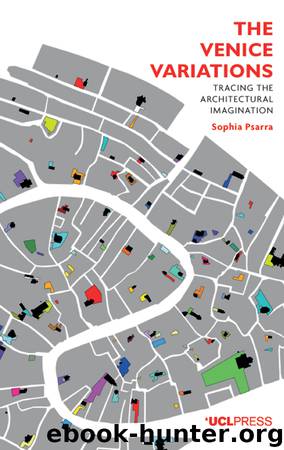The Venice Variations by Sophia Psarra;

Author:Sophia Psarra;
Language: eng
Format: epub
Publisher: Book Network Int'l Limited trading as NBN International (NBNi)
Published: 2018-03-19T16:00:00+00:00
Figure 3.8Italo Calvino. Invisible Cities. Diagram of narrative space-time (x-axis) and historical time (y-axis) in the penultimate dialogue between Marco Polo and Kublai Khan. Drawing by the author
As readers access a world of possibility through Polo’s cities and cities in our actual world, they are overcome by the desire to savour them and to transform them. They are thus made to consider the constraints that may prevent Polo’s fantastic cities from materialising; and the limitations in shaping their reality or previous realities that no longer exist. Conversely, readers are asked to examine why their particular reality has evolved in this way, whether it could have taken a different course or what prevents it from being transformed in the future. If Polo’s present, in Kublai’s garden (in the fiction), defines our historical past and if his future is our present, what he could once change (his future) he can change no more. But this makes us aware that our present affords possibilities for transformation. We leap back to Polo’s time and dash forward to current time not to change the possibility in the past that has materialised as the present, but to discover a third possibility that is not yet voiced but may exist. We can in this way look for the constraints that must be breached for it to be realised, in the combinatorial game of the possible.
Invisible Cities does not have a traditional closure like other narratives, advancing the action towards an end and a solution. Yet, by engulfing the reader in the fictional world at the end of the novel, Calvino offers a resolution to the dilemmas and dualities, the mirror-like oppositions and labyrinthine convolutions of images, arguments and thoughts contained in the description of cities and in the dialogues between the two actors. Instead of a relationship between Polo and the Khan (undisciplined imagination and analytical rationality), we are faced with a configurational interdependence between three parties. The two characters and their philosophical positions are at the end understood from a third perspective, the reader’s, the third channel whose very presence externalises and synthesises the encounter between the two opposite channels of thought: on the one hand, the imagination as possibility, which is spontaneous, random, inexplicable, infinite, subjective and episodic; on the other, analytical rationality, which is ordered, reasoned, objective and subject to universal laws and constraints.
The imagination, Calvino wrote, is the union of the ‘spontaneous generation of images and the intentionality of discursive thought, a plan carried out on the basis of a rational intention’.80 We recognise here Polo’s habit of generating images and the Khan’s interest in knowledge and discourse. Together they constitute Calvino’s imagination (and the reader’s) as an empirical historical person with a consciousness and unconsciousness. The second definition Calvino gave to the imagination is as something outside the self, ‘an electronic machine that takes account of all possible combinations and chooses the ones that are appropriate to a particular purpose’.81 The imagination spans the ‘repertory of what is potential, what is hypothetical,
Download
This site does not store any files on its server. We only index and link to content provided by other sites. Please contact the content providers to delete copyright contents if any and email us, we'll remove relevant links or contents immediately.
POP by Steven Heller(3307)
Japanese Design by Patricia J. Graham(3109)
The Power of Broke by Daymond John(2897)
Architecture 101 by Nicole Bridge(2764)
Indistractable: How to Control Your Attention and Choose Your Life by Nir Eyal(2333)
Fusion 360 for Makers by Lydia Sloan Cline(2308)
Batik by Rudolf Smend(2123)
Actionable Gamification: Beyond Points, Badges, and Leaderboards by Yu-kai Chou(2122)
Origami Art by Michael G. Lafosse & Richard L. Alexander(2065)
Homebody by Joanna Gaines(2031)
Whiskey in a Teacup by Reese Witherspoon(1936)
Worn in New York by Emily Spivack(1926)
Feng Shui by Stephen Skinner(1900)
Austin Kleon by Steal Like an Artist(1887)
Simple Gatherings by Melissa Michaels(1855)
Don't Make Me Think, Revisited: A Common Sense Approach to Web Usability by Steve Krug(1826)
Hygge: The Danish Art of Happiness by Marie Tourell Søderberg(1693)
The Joy of Hygge by Jonny Jackson(1685)
The Laws of Simplicity by John Maeda(1568)
